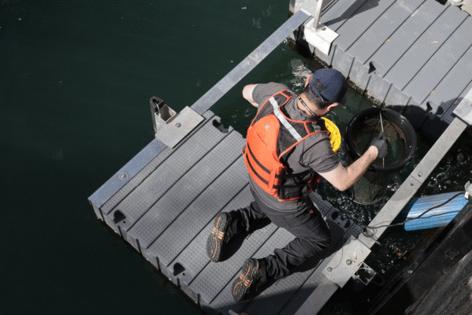Tiny pieces of plastic pose one of the biggest threats to Chicago River wildlife and water quality
Published in News & Features
CHICAGO — Wendella engineer Miguel Chavez climbed down a ladder and over a small dock Wednesday to pull up a trap floating in the Chicago River near the Michigan Avenue Bridge. The size of a standard garbage can, the trap is designed to collect trash and can hold up to 44 pounds.
Chavez tapped the bin three times to release the contents into a trash bag. At first glance, it looked like a brownish, wet pile of leaves and twigs.
“Once you start sifting through it, it’s a lot easier to see the trash,” he said.
While large trash is not as big of a threat, plastic debris from food and product packaging and the smaller bits from when it breaks down has emerged as a persistent problem that affects wildlife, water quality and public health.
“It’s no longer the dumping ground it was — it’s more of this incidental, wind-blown picnic, restaurant, parking lot pollution,” said Margaret Frisbie, executive director of the nonprofit Friends of the Chicago River. “What we used to find was shopping carts and sofas and tires and old pipes. … It was big and messy, but not the way that we see litter today. Today, the litter is smaller, it’s food-related. It’s breaking down because it’s plastic, and so it’s never really going away.”
In 2023, the Metropolitan Water Reclamation District collected 675 tons of debris from the river using skimmer boats; on average they pick up 745 tons annually, according to a spokesperson. City of Chicago skimmer boats also remove trash regularly along the Riverwalk downtown.
Between 75% and 95% of debris collected in the river is plastic, and 58% of identifiable, non-fragmented trash is food-related, according to research led by Tim Hoellein, an aquatic ecologist at Loyola University Chicago, and undergraduate student Caitlin Hyatt.
Shortly after the trap’s deployment last summer, Mike McElroy, director of marine operations at Wendella Tours and Cruises, discovered a plastic toy dinosaur when he emptied the trap one day. Now the trap’s official mascot, Trappy the Dinosaur has become an emblem for all the different kinds of things that pollute the river.
The Trash Trap is the first technology of its kind used in the Chicago River to remove litter and learn where it’s coming from and what it’s made of. Contraptions like this are typically used in marinas where tides rise slowly, but this one was modified to withstand rapid changes in river levels from heavy rainfall.
It works by drawing in water and debris from the surface using a submersible pump, trapping litter inside a catch bin and pumping the water back out.
...continued
©2024 Chicago Tribune. Visit at chicagotribune.com. Distributed by Tribune Content Agency, LLC.







Comments